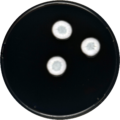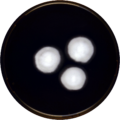Biology:Aspergillus viridinutans
| Aspergillus viridinutans | |
|---|---|
| Scientific classification | |
| Domain: | Eukaryota |
| Kingdom: | Fungi |
| Division: | Ascomycota |
| Class: | Eurotiomycetes |
| Order: | Eurotiales |
| Family: | Aspergillaceae |
| Genus: | Aspergillus |
| Species: | A. viridinutans
|
| Binomial name | |
| Aspergillus viridinutans Ducker & Thrower (1954)[1]
| |
Aspergillus viridinutans is a species of fungus in the genus Aspergillus. The species was first isolated in Frankston, Victoria, Australia and described in 1954.[1] It is from the Fumigati section of Aspergillus.[2] Several fungi from this section produce heat-resistant ascospores, and the isolates from this section are frequently obtained from locations where natural fires have previously occurred.[3] A. viridinutans has been identified as the cause of chronic aspergillosis.[4] The mycotoxin viriditoxin was first identified in A. viridinutans.[5][6] A draft genome sequence of the strain derived from the original species description has been generated.[7]
Growth and morphology
A. viridinutans can be cultivated on different medium sources, including both Czapek yeast extract agar (CYA) plates and Malt Extract Agar Oxoid® (MEAOX) plates. The growth morphology of colonies can be seen in the pictures below.
References
- ↑ 1.0 1.1 McLennan, E.I.; Ducker, S.C.; Thrower, L.B. 1954. New soil fungi from Australian heathland: Aspergillus, Penicillium, Spegazzinia. Australian Journal of Botany. 2(3):355-364
- ↑ Lamoth, F. (2016). "Aspergillus fumigatus-Related Species in Clinical Practice". Frontiers in Microbiology 7: 683. doi:10.3389/fmicb.2016.00683. PMID 27242710.
- ↑ Samson, R.A.; Hong, S.; Peterson, S.W.; Frisvad, J.C.; Varga, J. (2007). "Polyphasic taxonomy of Aspergillus section Fumigati and its teleomorph Neosartorya". Studies in Mycology 59: 147–203. doi:10.3114/sim.2007.59.14. PMID 18490953.
- ↑ Vinh, D.C.; Shea, Y.R.; Jones, P.A.; Freeman, A.F.; Zelazny, A.; Holland, S.M. (2009). "Chronic Invasive Aspergillosis caused by Aspergillus viridinutans". Emerging Infectious Diseases 15 (8): 1292–1294. doi:10.3201/eid1508.090251. PMID 19751595.
- ↑ Lillehoj, E. B.; Ciegler, A. (1972). "A toxic substance from Aspergillus viridi-nutans" (in en). Canadian Journal of Microbiology 18 (2): 193–197. doi:10.1139/m72-030. ISSN 0008-4166. PMID 4622987.
- ↑ Smyth, Jamie E.; Butler, Nicholas M.; Keller, Paul A. (2015). "A twist of nature – the significance of atropisomers in biological systems". Natural Product Reports 32 (11): 1562–1583. doi:10.1039/c4np00121d. PMID 26282828. https://ro.uow.edu.au/cgi/viewcontent.cgi?article=4391&context=smhpapers.
- ↑ Urquhart, AS; Hu, J; Chooi, YH; Idnurm, A (2019). "The fungal gene cluster for biosynthesis of the antibacterial agent viriditoxin". Fungal Biology and Biotechnology 6: 2. doi:10.1186/s40694-019-0072-y. ISSN 2054-3085. PMID 31304040.
Wikidata ☰ Q6733914 entry
 |



